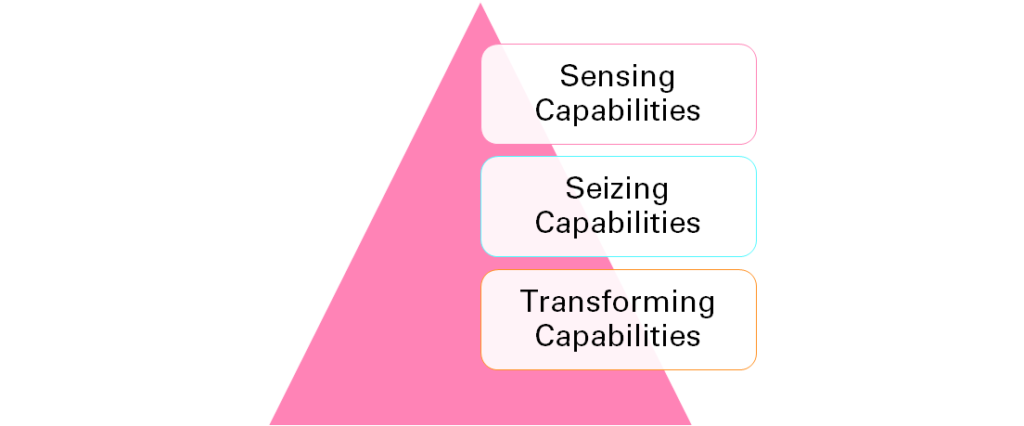In today’s fast-paced and ever-changing business landscape, high-performing organizations need to possess the right capabilities to navigate uncertainty, seize opportunities, and drive sustainable success. Among these capabilities, dynamic capabilities stand out as key drivers of high performance. Dynamic capabilities enable organizations to sense changes in the environment, seize new opportunities, and transform themselves to stay ahead of the competition. In this blog post, we will explore the three types of dynamic capabilities and illustrate their importance through relatable analogies.

The three types of dynamic capabilities are:
Sensing Capabilities
Sensing capabilities refer to an organization’s ability to identify and interpret changes in the external environment. This involves continuously scanning the market, monitoring customer needs, tracking industry trends, and gathering relevant data and information. Sensing capabilities allow organizations to stay attuned to shifts in customer preferences, emerging technologies, competitive dynamics, and other external factors that can impact their business.
Imagine a ship sailing through the vast ocean. To navigate safely and reach its destination, the ship relies on its radar system, which acts as its sensing capability. Similarly, high-performing organizations possess robust sensing capabilities that serve as their radar for detecting changes in the market, industry trends, and customer preferences. Just as a radar system scans the surroundings and alerts the ship to potential obstacles or opportunities, sensing capabilities allow organizations to gather market intelligence, monitor customer needs, and interpret external cues. By having a keen sensing capability, organizations can identify emerging trends, anticipate customer demands, and make informed strategic decisions.
Seizing Capabilities
Seizing capabilities involve the ability to take advantage of new opportunities or respond quickly to changing circumstances. This includes making timely decisions, allocating resources effectively, and implementing strategic initiatives. Seizing capabilities requires agility, flexibility, and a willingness to take calculated risks. Organizations with strong seizing capabilities are able to capitalize on emerging market trends, leverage their competitive advantages, and adapt their business models as needed.
Picture a cheetah swiftly hunting its prey in the African savannah. The cheetah’s ability to seize opportunities with lightning speed exemplifies seizing capabilities. High-performing organizations possess cheetah-like agility, enabling them to seize new opportunities or respond swiftly to changing market conditions. Just as the cheetah’s speed and agility enable it to adapt its tactics during the hunt, organizations with strong seizing capabilities can quickly allocate resources, make decisions, and execute strategic initiatives. They are nimble in adapting their business models, leveraging their strengths, and capitalizing on emerging trends. Seizing capabilities empower organizations to stay ahead of the competition and capitalize on market opportunities.
Transforming Capabilities
Transforming capabilities focus on an organization’s ability to reconfigure its resources, processes, and capabilities to adapt to new market conditions or pursue strategic objectives. This involves making fundamental changes to the organization’s structure, systems, culture, and technology. Transforming capabilities requires a willingness to embrace change, the ability to learn and unlearn, and the capacity to manage large-scale organizational transformations. Organizations with strong transforming capabilities are able to reinvent themselves and sustain long-term success in dynamic and disruptive environments.
Think of the miraculous transformation of a caterpillar into a butterfly. This profound metamorphosis serves as a powerful analogy for transforming capabilities. High-performing organizations possess the ability to transform themselves in response to changing market dynamics and strategic goals. Like a caterpillar, these organizations embark on a journey of change, reconfiguring their resources, processes, and capabilities to emerge as something new and remarkable. Transforming capabilities involve embracing organizational change, nurturing a culture of innovation, and adapting to disruptive forces. By continuously evolving and reinventing themselves, organizations can sustain long-term success in dynamic environments.
These three types of dynamic capabilities are interconnected and mutually reinforcing. Sensing capabilities provide the foundation for identifying opportunities and threats, which then informs the organization’s seizing capabilities to act upon those insights. Transforming capabilities, in turn, enable organizations to adapt and evolve over time, building on their sensing and seizing capabilities to stay ahead of the competition and thrive in changing markets.